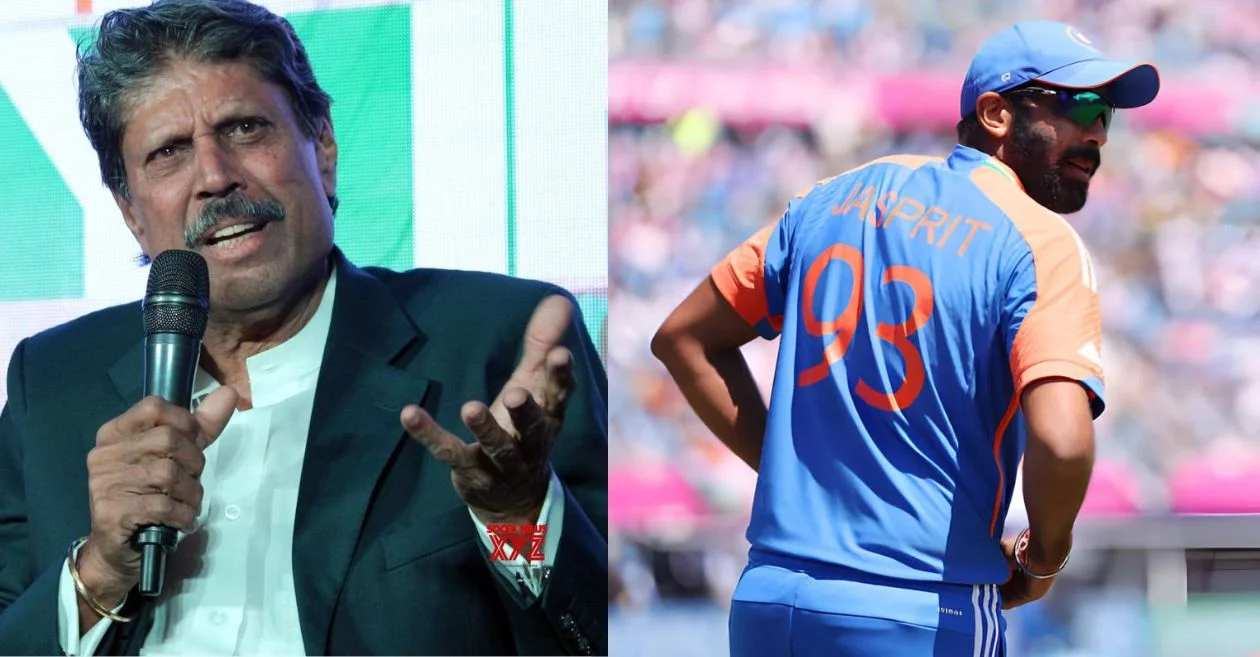In the ongoing ICC Men’s T20 World Cup 2024, Indian fast bowler Jasprit Bumrah has emerged as a standout performer for the Men in Blue. With his impeccable bowling skills, Bumrah has played a pivotal role in securing victories for the Indian cricket team in their initial encounters against Ireland and Pakistan. His ability to deliver under pressure has undoubtedly bolstered India’s campaign in the tournament.
Jasprit Bumrah’s Role Under Scanner
Despite his remarkable performances, questions have been raised regarding Bumrah’s role in the Indian team’s strategy. Former cricketers and legends of the game, including ex-India captain Kapil Dev, have expressed their concerns over the management’s decision not to utilize Bumrah’s potential to its fullest. It’s noteworthy that in both matches against Ireland and Pakistan, Bumrah did not open the bowling for India. Instead, the new ball was handed to Arshdeep Singh and Mohammed Siraj. However, Bumrah’s exceptional display on the field earned him the Player of the Match award in both instances, further highlighting his indispensable contribution to the team’s success.
Kapil Dev’s Critique
Kapil Dev, one of India’s most celebrated cricket legends, has been vocal about his views on how Bumrah should be utilized. He emphasized the importance of deploying Bumrah at the forefront of India’s bowling attack. He underscored Bumrah’s ability to take wickets early on, asserting that such a strategy would exert pressure on the opposition and provide a significant advantage to the Indian team.
“He needs to bowl the first over, he is a wicket-taking bowler. If you make him bowl the fifth or sixth bowler, the game can slip out of your hands,” said Kapil.
Kapil’s critique is rooted in the belief that Bumrah’s unique bowling style and ability to strike early in the innings could change the dynamics of the game in India’s favor. His views resonate with many fans and experts who believe that Bumrah is underutilized when he is not given the new ball.
The Strategic Importance of Early Wickets
Kapil Dev’s insistence on utilizing Bumrah early in the innings is backed by the strategic importance of taking early wickets in T20 cricket. Early breakthroughs can derail the opposition’s batting plans, forcing them to adopt a more cautious approach. This, in turn, can lead to a domino effect where other bowlers can capitalize on the pressure created by early dismissals.
“This is not a Test match. This is T20. The quicker you take wickets, the more pressure it puts on the opposition. It is better to have a positive mindset. If Bumrah opens the bowling and picks up a couple of wickets, life becomes easier for the other bowlers as well,” added Kapil.
Kapil’s assertion is that in the fast-paced nature of T20 cricket, quick wickets are crucial for maintaining control over the game. By leveraging Bumrah’s ability to strike early, India can set a tone that could potentially dominate the opposition throughout the innings.
Bumrah’s Performance and Adaptability
Jasprit Bumrah’s performance in the T20 World Cup so far has been nothing short of exceptional. His ability to adapt to different match situations and deliver under pressure has made him a vital asset for the Indian team. In both matches against Ireland and Pakistan, Bumrah showcased his versatility by bowling effectively in the middle and death overs, proving his worth as a complete bowler.
His ability to execute yorkers, slower balls, and bouncers with precision makes him a formidable opponent for any batting lineup. Bumrah’s knack for breaking partnerships and containing runs during crucial phases of the game has been instrumental in India’s success in the tournament.
The Debate on Bumrah’s Opening Role
The debate on whether Bumrah should open the bowling for India stems from his proven track record as a wicket-taker. Critics argue that by holding him back for the middle or death overs, India might be missing an opportunity to dismantle the opposition’s top order early in the innings. However, the team management’s strategy of using Bumrah in different phases of the game has also yielded positive results.
It is a delicate balance between utilizing Bumrah’s strengths and adapting to the match situation. While opening the bowling with Bumrah can provide early breakthroughs, saving him for the crucial death overs ensures that India has a potent weapon to control the game’s final stages.
The Path Forward: Balancing Strategy and Execution
As India progresses in the T20 World Cup, the management’s challenge will be to find the optimal way to utilize Jasprit Bumrah’s skills. The balance between deploying him as an opening bowler to secure early wickets and preserving his overs for the death to control the run flow will be crucial.
Rohit Sharma and the coaching staff must weigh the benefits of each approach and make decisions based on match conditions and the opposition’s strengths. Flexibility and adaptability will be key, and Bumrah’s role may vary from game to game to maximize his impact.
Bumrah’s Indispensable Role in India’s Campaign
Jasprit Bumrah’s contributions to India’s T20 World Cup campaign have been invaluable. His ability to perform under pressure and deliver match-winning performances highlights his importance to the team. While there are differing opinions on how best to utilize his skills, there is no doubt about his status as one of the premier bowlers in world cricket.
As the tournament progresses, Bumrah’s role will continue to be scrutinized and debated. However, his performances so far have proven that he is a match-winner, capable of turning the tide in India’s favor. Whether opening the bowling or finishing off the innings, Jasprit Bumrah remains a pivotal figure in India’s quest for T20 World Cup glory.
Please check for information on the best betting sites in India and IPL betting sites – https://selectory.org/best-betting-sites/
Related posts:
 Aaron Finch picks Virat Kohli’s batting position for the T20 World Cup 2024
Aaron Finch picks Virat Kohli’s batting position for the T20 World Cup 2024
 England unveil 15-man squad for T20 World Cup 2024; Jofra Archer returns
England unveil 15-man squad for T20 World Cup 2024; Jofra Archer returns
 Fraser-McGurk and Smith left out of Australia’s T20 World Cup squad, Marsh to captain
Fraser-McGurk and Smith left out of Australia’s T20 World Cup squad, Marsh to captain
 Delhi Police hilariously trolls Pakistan after India’s thrilling win over Pakistan; tweet goes viral | T20 World Cup 2024
Delhi Police hilariously trolls Pakistan after India’s thrilling win over Pakistan; tweet goes viral | T20 World Cup 2024
 T20 World Cup: Cricket experts erupts over dead-ball rule after Bangladesh lose to South Africa
T20 World Cup: Cricket experts erupts over dead-ball rule after Bangladesh lose to South Africa
 Shahid Afridi blasts Pakistan for their humiliating defeat against India at T20 Word Cup 2024
Shahid Afridi blasts Pakistan for their humiliating defeat against India at T20 Word Cup 2024
 T20 World Cup 2024: Major DRS Controversy Denies Bangladesh Win Over South Africa, ICC Rule Exposed
T20 World Cup 2024: Major DRS Controversy Denies Bangladesh Win Over South Africa, ICC Rule Exposed
 USA vs IND, T20 World Cup: Match Prediction, Dream11 Team, Fantasy Tips & Pitch Report | United States of America vs India 2024
USA vs IND, T20 World Cup: Match Prediction, Dream11 Team, Fantasy Tips & Pitch Report | United States of America vs India 2024
 T20 World Cup : Tim David takes a splendid running catch to dismiss Ben Shikongo in AUS vs NAM game
T20 World Cup : Tim David takes a splendid running catch to dismiss Ben Shikongo in AUS vs NAM game
 T20 World Cup 2024: Mitchell Marsh names the ‘most important player’ in the Australian team
T20 World Cup 2024: Mitchell Marsh names the ‘most important player’ in the Australian team
 Pakistan’s captain Babar Azam gives a touching present to an emotional child mascot | T20 World Cup 2024
Pakistan’s captain Babar Azam gives a touching present to an emotional child mascot | T20 World Cup 2024
 WI vs NZ, T20 World Cup: Match Prediction, Dream11 Team, Fantasy Tips & Pitch Report | West Indies vs New Zealand 2024
WI vs NZ, T20 World Cup: Match Prediction, Dream11 Team, Fantasy Tips & Pitch Report | West Indies vs New Zealand 2024
 Reason behind Team India’s search for a gym in New York | T20 World Cup 2024
Reason behind Team India’s search for a gym in New York | T20 World Cup 2024
 T20 World Cup 2024: USA star Aaron Jones reveals their ‘biggest challenge’ against the mighty Team India
T20 World Cup 2024: USA star Aaron Jones reveals their ‘biggest challenge’ against the mighty Team India
 USA’s Indian-origin players express the special feeling of facing India in T20 World Cup 2024
USA’s Indian-origin players express the special feeling of facing India in T20 World Cup 2024
